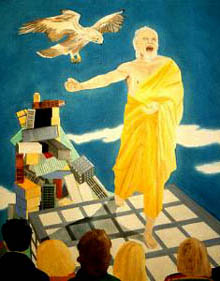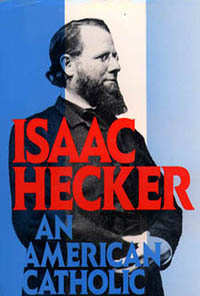 |
What People Are Commenting
Zarathustra and Vatican II

|
When Nietzsche proclaimed the death of God, he realized that his message carried an intrinsic and horrifying danger. Belief in God, and its opposite, the war against God (such as Albert Camus fought a little later) improved man. But with God's death, man could abandon all striving, all interior and exterior movements towards higher things.
Nietzsche reasoned that unless a surrogate for God was given, the result might well be a downward drift where man would be motivated only by the desire for comfortable self-preservation. He called the person who would follow this course the last man, most despicable in being, because he is no longer able to despise himself. He wants neither riches nor poverty, he doesn't want to rule or be ruled, and he wants everyone to be the same, total equality in saccharine lukewarmness.

Zarathusta warns about future society to no effect
|
To try and prevent this corruption, Nietzsche's Zarathustra takes two tasks upon himself. First, to describe this sickening last man to people, in order to warn them of the hazard; second, to instill in his listeners the desire to reject softness and embrace courage and strength. But per contra, when the last man is described to the people, they are enthralled. The last man is their ideal of contemporary modern man! (1)
Adherents to the Second Vatican Council are in a position considerably worse that those who listened and rejected the warning of Zarathustra. When advised that God is dead, his listeners could at least ponder the truth of it. Conversely, they who absorbed the spirit of the Council didn't have this luxury. By utilizing deliberate, cunning and diabolical ambiguities in counciliar documents, the Hierarchy got the message out to priests, religious and laity that they could have it all. The teachings of new-church would allow them to retain their Catholicism and lead a life of comfortable self-preservation at the same time.
Walk into a new-church building during the new rite and behold the opposite of austerity, mystery and hierarchy. Fellowship, hand-holding, no sacrificial altar, circular ambience signifying egalitarianism, sensuous music. The ensemble makes everyone feel he is good, and he no longer has the capacity to despise himself (the confessional is fading away, as are kneelers, both of which detract from comfort and feeling good). This condition in postconciliarism gets worse with each year, because the people of God listen to each other instead of preconciliar truths. They are all one in their drive to the last cosmic man. The fathers of the Council knew what they were doing. They had a blueprint to follow, with two sets of principles.
The first one came from Father Isaac Hecker, who founded the Paulist Fathers in America in 1858, which gave him ipso facto the authority of Catholic leadership. He used this authority as a weapon to spread his ideas - known as Americanism - among Modernists, and thus to undermine the Catholic Church.
There were four major marks of his plan:
- The necessity of the adaptation of the Church to the exigencies of modern civilization, by relaxing its severity and orienting it to a more democratic institution;
- More latitude for individual freedom of thought and action, since the Holy Spirit acts on the individual conscience more directly than the hierarchical organization i.e. Protestantism;
- Concentration of the active virtues rather than the passive;
- Favoring the religious congregations of active life rather than the contemplative.

A vanguard thinker for Vatican II
|
Leo XIII, perceiving that these tenets would work on the tendencies of man, reacted to Hecker's ideas with the words, "We cannot approve these opinions which constitute the so-called Americanism." In 1889 the Holy Father promulgated the apostolic letter Testem Benvolentiae, to make his authority known on the matter, that such thinking would undermine Catholic teaching and the Catholic spirit.
Alas, his authority was overruled by Vatican II, who understood fully the value of Hecker's ideas and how they would support the tendentious revolution. All four of the errors of Americanism rule the mainstream in the new order, not only in the tendencies, but in the very souls of many - perhaps most - Catholics.
The second principle was from the 19th century war theorist Carl von Clausewitz, a Prussian army officer. Clausewitz's principle of the center of gravity is admired by those in the business of war. Translated it means "the hub of all power and movement on which everything depends. (2) Four years after the termination of the Council, the final salvo was fired, and exploded the Mass into nothingness, the center of Catholic worship. It was replaced by a new rite that has so many forms (a quarter of a million licit forms, not including the illicit), so that one never knows the substance of the service. (3)
Writing in the early part of the 20th century about the dystopian future of the Church and the world, where humanism triumphs over religion, Robert Benson stated: "Humanitarianism would presently put on the dress of liturgy and sacrifices, and when that was done, the Church's cause, unless God intervened, would be over. (4)
After the Council and the introduction of the new rite, only a few years were needed to seduce all but a remnant. The ruthless evil of this plan and its successful operation on the tendencies can be observed by all, because it is the great evidence of the age that the Catholic Church is in total shambles. The AIDS virus continues to infect all but the Remnant.
L.A.
1. Thus Spoke Zarathustra, Prologue, section 5.
2. On War, Carl von Clausewitz, NY: Everyman's Library, 1993, p. 720
3. The Latin Mass magazine, Summer 1997, pp. 44 - 45. A letter written in 1969 by Father Bryan Houghton MA was printed in this issue, pointing out how the Roman rite had two forms, Low and High, which were symbols of unity. In the Novus Ordo, however, "If every licit combination of four canons, back and front, silent and audible, sung and said, Latin and vernacular in part or whole, High, concelebrated and Low, with and without lay participation in varying degrees, and so on, if all these were taken into account, there would be some 250 rites which, multiplied by an odd thousand languages and dialects, would give a quarter of a million licit forms of Mass... The fact is that Christian prayer is a supernatural act directed by the supernatural gift of faith. It is a not a process of natural reasoning. By reducing the supreme prayer of the Mass to the human activity of intellectual understanding there is a grave danger of teaching the faithful how not to pray."
4. Lord of the World, Christian Book Club of America: Hawthorne, CA, 1971, p. 136.

Posted January 15, 2007

The opinions expressed in this section - What People Are Commenting -
do not necessarily express those of TIA

Related Topics of Interest
 Revolution and Counter-Revolution: Overview Revolution and Counter-Revolution: Overview
 RCR in the Tendencies, Ideas and Facts RCR in the Tendencies, Ideas and Facts
 The Lutheran and Calivinist Mentalities The Lutheran and Calivinist Mentalities
 Eric Gill, a Precursor of Vatican II Eric Gill, a Precursor of Vatican II
 The Fidelity of the Remnant Through History The Fidelity of the Remnant Through History
 Counter-Revolutionary Personalities Counter-Revolutionary Personalities

|
Comments |
Questions |
Objections |
Home |
Books |
CDs |
Search |
Contact Us |
Donate

© 2002-
Tradition in Action, Inc. All Rights Reserved
|
 |
|